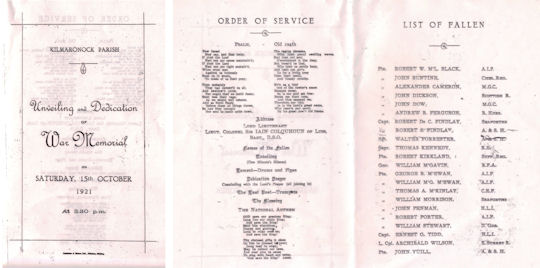The Local War Memorials
How to find a name of the Alexandria Cenotaph
The names of each of the Fallen appear in alphabetical order within rank within regiment or unit. Thus when looking for a name on the Cenotaph the first thing to find is the Tablet on which the Regiment or Unit in which he served appears. This simple plan of the layout should help:
East Side of the Cenotaph i.e. facing Main Street, 3 tablets:
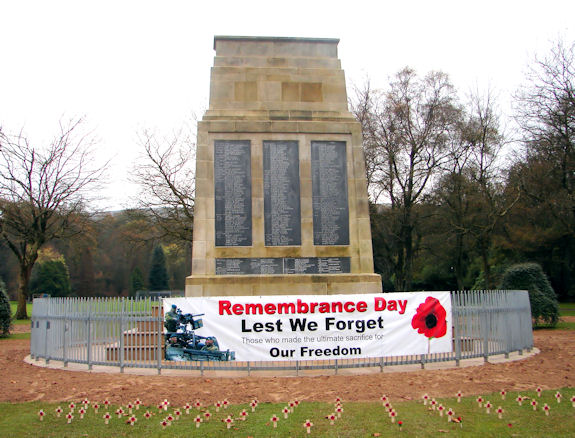
Royal Navy |
Royal Scots |
Scottish Rifles (The Cameronians) |
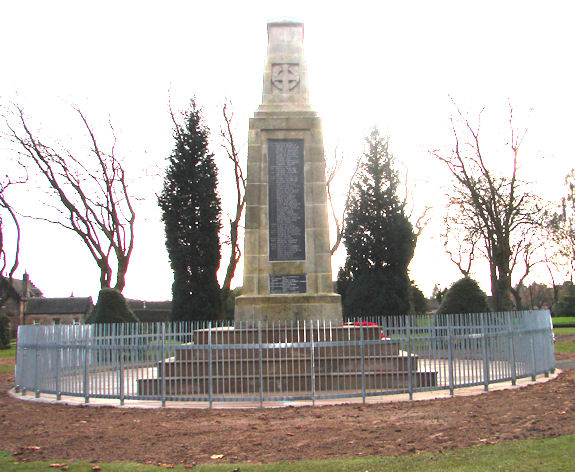
North Side of the Cenotaph (facing the Hospital Field) 1 tablet
Seaforth Highlanders |
Argyll & Sutherland Highlanders, the whole tablet. |
Argyll & Sutherland Highlanders
Royal Defence Corps |
Machine Gun Corps |
West Side of the Cenotaph (overlooking the play areas of the Christie Park) 3 tablets
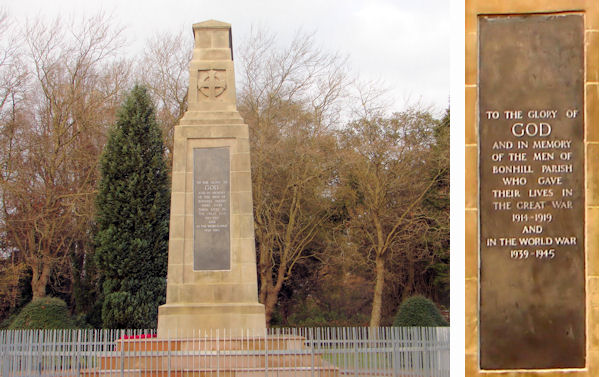
South Side of Memorial Dedication and Inscription
The Regiments / Units in which the Men Served
The Regimental / Unit Affiliations of the men on the Alexandria Cenotaph are as follows
| No | Unit / Number of men | No | Unit / Number of Men |
| 1 | Argyll & Sutherland Highlanders, 112 | 23 | New Zealand Forces, 2 |
| 2 | Gordon Highlanders, 28 | 24 | 2nd Dragoon Guards, 2 |
| 3 | Seaforth Highlanders. 18 | 25 | Kings Liverpool Regiment, 2 |
| 4 | Black Watch, 16 | 26 | Royal Irish Fusiliers, 2 |
| 5 | Royal Scots, 15 | 27 | 9h Lancers, 1 |
| 6 | Royal Scots Fusiliers, 15 | 28 | Forfar Yeomanry, 1 |
| 7 | Cameronians (Scottish Rifles), 14 | 29 | Lovat Scouts, 1 |
| 8 | Highland Light Infantry, 14 | 30 | Royal Horse Artillery, 1 |
| 9 | Royal Field Artillery, 12 | 31 | Northumberland Fusiliers, 1 |
| 10 | Kings Own Scottish Borderers, 11 | 32 | West Yorkshire Rifles, 1 |
| 11 | Canadian Expeditionary Force, 11 | 33 | Royal Irish Regiment, 1 |
| 12 | Royal Engineers, 10 | 34 | Inniskilling Fusiliers, 1 |
| 13 | Australian Imperial Force, 9 | 35 | Border Regiment, 1 |
| 14 | Royal Garrison Artillery, 9 | 36 | Sherwood Forresters, 1 |
| 15 | Machine Gun Corps, 8 | 37 | Royal West Kent, 1 |
| 16 | Royal Navy, 6 | 38 | Durham Light Infantry, 1 |
| 17 | Royal Air Force, 6 | 39 | Royal Defence Corps, 1 |
| 18 | Cameron Highlanders, 6 | 40 | Tank Corps, 1 |
| 19 | Army Service Corps, 6 | 41 | London Regiment, 1 |
| 20 | Scots Guards, 6 | 42 | Ordnance Corps, 1 |
| 21 | South African Forces, 3 | 43 | African Rifles, 1 |
| 22 | Transport Services (Merchant Navy), 2 | 44 | US Army, 1 |
It comes as no surprise that 30% of the men listed on the Cenotaph died serving in the local regiment, the Argyll & Sutherland Highlanders, but it probably does come as a surprise that the second regiment on the list was the Gordon Highlanders based in Aberdeen and that the next two regiments were also Highland Regiments, the Seaforths (based in Dingwall) and the Black Watch (Perth). It may well be that old family loyalties had some influence but the greatest influence was that the Army directed the men into the units with the greatest need.
The Vale of Leven Academy Roll of Honour
During WW1 the rector of the Academy, Mr Duncan McIntyre kept a record of former pupils and staff members who died during the war. At the War’s end there were 64 names on the list – 60 former pupils and 4 staff members. A plaque was made listing their names and it was unveiled on Saturday 26th June 1920 by Sir Iain and Lady Colquhoun. It was therefore one of the first of the War memorials to be unveiled in the Vale and the names on this memorial were of course available to the Bonhill Parish War Memorial Committee, although not all of them were used any of the Vale area Committees (see below).
The plaque cost £150 and was paid for by a number of local benefactors including William J Kippen of Westerton House at Ballagan, Major Adair Campbell of Tullichewan Castle who had lost a 16 year old son at the Battle of Jutland and Mrs Belle Westland who owned shops in Alexandria and one of whose sons’ name appears on the both the Academy and Alexandria Memorials.
In 2010 a recreated Memorial was placed at the entrance to the new Academy building.
| Thomas Aitchison | William H Fanning | Duncan Kerr | George McCormick | Robert McRae |
| Andrew J Aitchison | Jack Farquhar | Robert Kerr | John McCrimmon | Hugh McVean |
| Robert Aitken | John Ferguson | David S Lang | Alfred McFarlane | Thomas Napier |
| James FM Angus | Alex C Finlayson | William Lee | Robert McGill | John Paul |
| John T Bailes | Peter Finlayson | James R Lindsay | John McIntyre | John Ritchie |
| James Bisland | Hugh Fleming | James Malcolmson | James McKean | Peter Robinson |
| William Campbell | James R Galbraith | Robert Mathieson | William McKechnie | John F Steven |
| James Constable | John Graham | George Melville | Francis McKinlay | Edward B Westland |
| William Davie | Peter Graham | Charles Miller | Thomas A McKinley | David Weir |
| William Y Dempster | Willm Bardo Hodge | Hugh Miller | James McLean | Thomas Whitelaw |
| David Dick | Roy Howard | John Miller | James McLelland | John Wilson |
| Daniel W Dugan | James Irving | Alex McD Moir | John McLintock | William Wright |
| Alex McL Fanning | James Izatt | Dugald McArthur | Mathew McNicol |
As would be expected, of the 64 names all but 11 appear on one of the local memorials – most of them on the Alexandria Cenotaph, but 3 on the Renton War Memorial and 1 on Kilmaronock.
The names which are missing from other Memorials are:
- Andrew J Aitchison
- John T Bailes
- James Bisland
- David Dick
- Daniel Dugan
- William Bardo Hodge
- James Izatt
- Duncan Kerr
- Robert Kerr
- Robert Mathieson
- John Steven
Kilmaronock Parish War Memorial
Introduction
One major decision everywhere in the building of War Memorials was finding an appropriate setting. Kilmaronock is spoiled for choice in terms of settings, but the site which was offered and accepted at a fairly early stage was probably the best of them all. Kilmaronock’s Parish War Memorial occupies one of the finest sites of any war memorial in Scotland and perhaps in the whole of the UK. It stands about halfway between the village of Gartocharn and Kilmaronock Parish Church and looks northward over Loch Lomond and its islands, Ben Lomond and the southern highland mountains and hills as far Crianlarich, which in practice is as far as the eye can see. It was a fitting place to honour the young men of the Parish who gave their lives in both World Wars.
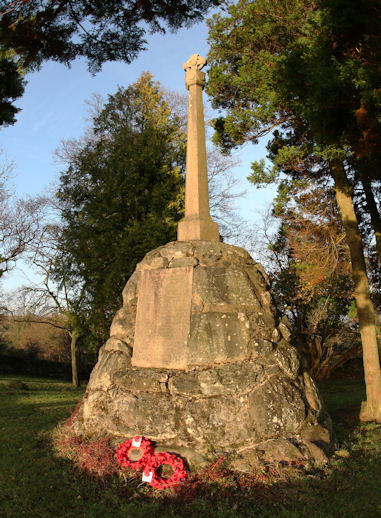 Unfortunately time has not been kind to the site, but no one could have foreseen that in the early 1920’s. It stands immediately adjacent to the very busy A811 road on a fast corner with no entrance from the road and no parking. Gaining safe access to the Memorial is very difficult. This problem has been recognised for many years and two main suggestions have been made about moving the Memorial to a safer, more accessible location.
Unfortunately time has not been kind to the site, but no one could have foreseen that in the early 1920’s. It stands immediately adjacent to the very busy A811 road on a fast corner with no entrance from the road and no parking. Gaining safe access to the Memorial is very difficult. This problem has been recognised for many years and two main suggestions have been made about moving the Memorial to a safer, more accessible location.
The first of these was to move it to the middle of Gartocharn village. Naturally, the residents of Croftamie objected; it was after all the Parish War Memorial and if was going to be moved to a village, then Croftamie had equal claim. So that proposal was shelved.
The second proposal was to move it to a spot in the precincts of Kilmaronock Parish Church where both village neutrality and the view could be maintained. The objections to this site was that it would be seen as having religious overtones favouring the Church of Scotland and might offend other religions. Its not clear that anyone actually consulted the other religions, nor what their views were. In any event, when the estimated cost of such a move became known – about £35,000 at that time – the matter was quietly dropped and there the matter still rests. Perhaps the authorities will one day provide safe access for people wishing to pay their respects to those who made the supreme sacrifice as well as thinning out the foliage which has closed in around the Memorial.
To-day’s problems were certainly not the fault of its original planners and builders who could not have foreseen to-day’s traffic. Indeed, a benefit of the site when it was offered to the War Memorial Committee was that it was adjacent to the quiet country road which ironically had originally been built as the Dumbarton – Stirling military road in the wake of the ’45. As we shall see, two local landowners played a key role in the siting of the Memorial and it is to their great credit that the monument retains its stunning setting.
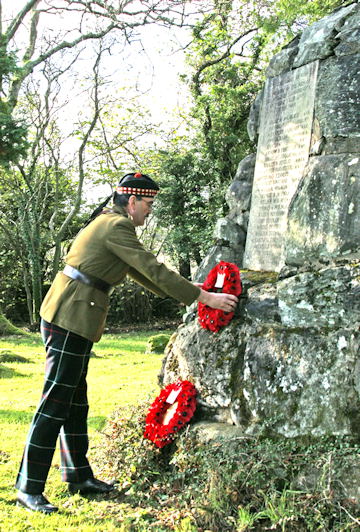 Building of the Memorial
Building of the Memorial
As in every other parish in the United Kingdom, as the Great War drew to a close preparations were made in Kilmaronock Parish for the building of a suitable memorial for the local men who had been killed in the war. With so many local landowners living in the Parish raising money was not going to be a problem nor was the collecting of names.
The site was donated by local landowner and farmer, Mr Cunningham Lenny of Gartocharn,. who belonged to a branch of the Graham family of the Dukes of Montrose. The Cunningham Lennys had owned farms around Gartocharn for about a century by then, and indeed they were still landowners and farmed near the village until the 1960’s.
This very generous donation was matched by an equally generous promise by the adjoining landowner, Sir Alexander W Leith-Buchanan, whose family ties with Gartocharn went even further back than Mr Cunningham-Lenny. He undertook that he would restrict the adjoining fields to appropriate “agricultural and pastoral purposes” so that nothing would spoil the magnificent view or the solemnity of the memorial. That is a promise which has survived to this day through a couple of generations of the Leith-Buchanan family and is a great credit to them.
The memorial was designed by Mr D Y Cameron of Dun Eaglais, Kippen who also designed the Bonhill Parish War Memorial in Alexandria and it was built under the supervision of Mr E S Bell, architect, Stirling. The base was built of local stone by Mr Robert Currie of Gartocharn and the plate and shaft, which are of Peterhead granite, was supplied by Mr Thomas Ross, Stirling.
The Unveiling of the Memorial
Lt Colonel Sir Iain Colquhoun of Luss, Lord Lieutenant of Dunbartonshire, performed the ceremony of unveiling and dedicating the Kilmaronock War Memorial on Saturday 15th October 1921 at 3.30 pm in the presence of a large crowd. At the end of the ceremony, the Reverend William Goldie who was the Parish Minister at Kilmaronock for many years offered up a prayer.
We are grateful to Bobby Bain for supplying the copy of the Programme for the Unveiling Ceremony.
Click this image to view larger version
The latter half of 1921 must have been a pretty melancholy time for Sir Iain because he was called upon to unveil many of the War Memorials in the County and met perhaps thousands of grieving relatives – a duty he carried out with great dignity. At the smaller memorials he made it a practice to read out the names of the dead who were remembered on the memorial. At Kilmaronock he read, in alphabetical order, not in rank, the names of the 22 local men who died in the Great War and who are commemorated on the Memorial.
The Names from the Great War on the Kilmaronock War Memorial
The 22 men who are commemorated on the Kilmaronock War Memorial are:
- Robert W McL Black, Private in the Australian Imperial Force
- John Buntine, Private in the Cheshire Regiment
- Alexander Cameron, Private in the Machine Gun Corps
- John Dickson, Private in the Scottish Rifles, the Cameronians
- John Dow, Private in the Machine Gun Corps
- Andrew R Ferguson, Private in the Royal Highlanders, the Black Watch
- Robert de C Findlay, Captain, in the Seaforth Highlanders
- Robert S Findlay, Captain in the Argyll & Sutherland Highlanders
- Walter Forrester, Sergeant in the Argyll & Sutherland Highlanders
- Thomas Kennedy, Sapper in the Royal Engineers
- Robert Kirkland, Private in the Suffolk Regiment
- George B McEwan, Private in the Australian Imperial Forces
- William McG McEwan, Private in the Australian Imperial Forces
- William McGavin, Gunner in the Royal Field Artillery
- Thomas A McKinlay, Private Canadian Expeditionary Forces
- William Morrison, Private in the Seaforth Highlanders
- John Penman, Private in the Highland Light Infantry
- Robert Porte, Private in the Australian Imperial Forces
- William Stewart, Private in the Dragoon Guards
- Ernest G Tidd, Captain in the Highland Light Infantry
- Archibald Wilson, Lance Corporal East Surrey Regiment
- John Yuill, Private Argyll & Sutherland Highlanders
The Regiments / Units in which the Men Served
| No | Regiment / Unit | No | Regiment / Unit |
| 1 | Australian Imperial Forces, 4 | 8 | Cameronians (Scottish Rifles), 1 |
| 2 | Argyll & Sutherland Highlanders, 3 | 9 | Black Watch (Royal Highlanders), 1 |
| 3 | Highland Light Infantry, 2 | 10 | Royal Engineers, 1 |
| 4 | Machine Gun Corps, 2 | 11 | Suffolk Regiment, 1 |
| 5 | Seaforth Highlanders, 2 | 12 | Royal Field Artillery, 1 |
| 6 | Canadian Expeditionary Force, 1 | 13 | Dragoon Guards, 1 |
| 7 | Cheshire Regiment, 1 | 14 | East Surrey Regiment, 1 |

